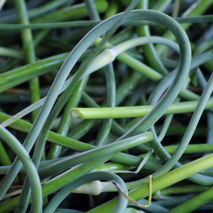At Dragonfly Hill Farm and Kitchen, we seek to leave things better than we found them. One way we live into this value is by minimizing waste on the farm. Our goal is to use everything we can and keep waste out of the landfill.
Garlic scapes are a potential area of waste on the farm each spring. Garlic Scapes are the stems and buds of our hardneck garlic that pop up in May and June. We have to cut them off the plants so that the bulbs grow. If we have hundreds of garlic plants, that means hundreds of garlic scapes.
Fortunately, thanks to a combination of delicious recipes and on-farm composting, we get to use the garlic scapes as fuel for both our bodies and our farm. There’s no waste. Continue reading to learn how we do it.
Garlic Scapes are Even more Versatile than Garlic!
Garlic scapes are a natural part of the garlic growth process. However, they impede our garlic growth goals. When scapes are growing, the plant devotes a lot of energy to them, rather than directing that energy towards growing the largest, most flavorful bulbs underground. So, we have to cut the scapes.
Each garlic plant grows a single scape. It looks like a cross between a scallion and a chive with a bulb-shaped bud in the center. The scapes coil as they grow. I like to harvest the scapes when they form circles. You can cut the scape at its base or pull it off with your hands.
When it comes to scapes, the plant’s loss is our culinary gain! Garlic scapes have a mild garlic flavor that can be enjoyed raw or cooked.
Here are some of my favorite ways to eat garlic scapes:
- Garlic Scape Pesto – Substitute garlic scapes for some or all of the basil in your favorite pesto for a rich, garlicky spread or pasta sauce.
- Grilled Garlic Scapes – Grill the scapes whole and serve as a side dish with your favorite grilled meats or vegetables.
- Garlic Scape Compound Butter – Thinly slice garlic scapes and mix with butter. Then roll in parchment paper and freeze. Use the compound butter for garlic bread, to top steaks, or on pasta.
- Garlic Scape Stir Fry – Slice scapes into two-inch slices and add to your favorite stir-fry recipe in place of minced garlic.
- Pickled Garlic Scapes – Use your favorite quick pickle recipe to make pickled garlic scapes that will add extra zest and acid to your salads, sandwiches, and more.
However you choose to enjoy them, garlic scapes are one of the most flavorful treats of spring! Their versatility is unmatched and the mild garlic flavor makes every meal better. Plus, they are the perfect way to honor our garlic plants and avoid waste.
Compost Reduces Waste and Improves Soil
Sometimes there are too many garlic scapes to eat. Rather than throwing the extra scapes in the trash, we put them in our compost pile to turn into nutrient-dense organic matter to enhance our soil.
Compost is a supplement that adds nutrients, moisture, and healthy microorganisms to the soil. It’s formed through a natural decomposition process that breaks down yard and garden trim and kitchen scraps into organic matter.
Compost is free and easy to make. It provides an organic alternative to synthetic fertilizers and prevents our trim and scraps from going to waste. We love compost!
Last year, most of the farm was under construction, so we only had a small compost pile. Clients would bring their veggie scraps. Then we added grass clippings and small wood chips and branches. This year we are building three permanent bins to expand our compost program and reduce waste.
Healthy compost requires a careful balance of carbon and nitrogen. You need twice as much carbon-rich matter like dried leaves, sticks, sawdust, and shredded paper bags as nitrogen-rich matter like grass clippings, veggie scraps, and garlic scapes. This combination provides the right environment for the microorganisms that break down the pile.
You also need ample air and moisture. Our compost bins will have holes in the side to let air in. We will add water as needed to keep the compost the dampness of a wrung-out sponge. We also need to turn the compost piles occasionally which is why we will have three bins.
Moving the compost from bin to bin aerates it and helps it heat to an internal temperature between 130 and 160 degrees. This heat prevents weed and pathogen growth and facilitates the decomposition process.
Once the compost is done, we let it sit for 4 weeks then spread it in the fields to enhance our soil. Instead of wasting all those food and garden scraps or sending them to the landfill, we are able to put them back into our soil and make the land healthier than it was.
Farming is all about utilization. Nothing should go to waste from a garlic scape to a grass clipping. Thanks to the delicious scape recipes and the microorganisms hard at work in our compost pile, we are able to use waste to nourish ourselves and our soil.




